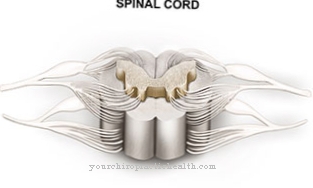Lymphocytes, which themselves are subdivided into a multitude of manifestations with different tasks, represent a subgroup of leukocytes. With a few exceptions, they are part of the acquired immune system, and their relative share in the total number of leukocytes is normally 25 to 45 percent of the leukocytes . If the relative proportion or the absolute number falls below a certain value, there is a Lymphopenia in front.
What is lymphopenia?

© fotoliaxrender - stock.adobe.com
As Lymphopenia is a pathologically low absolute or relative number of lymphocytes in the blood. Lymphopenia actually embodies lymphocytopenia. Lymphocytes, which are a subgroup of leukocytes, the white blood cells, can themselves be subdivided into a multitude of different cell types with different tasks in the acquired immune system.
In principle, lymphopenia can be divided into an absolute and a relative form. Absolute lymphopenia is when the number of lymphocytes falls below 1000 cells per microliter of blood. In relative lymphopenia, the proportion of lymphocytes within the group of leukocytes is less than 15 percent or, according to other authors, less than 25 percent.
There is no standardized, binding benchmark. Normally the relative proportion of lymphocytes is around 20 to 40 percent of the total number of leukocytes. Absolute lymphopenia is more meaningful with regard to its physiological effect because the relative value depends on the total number of leukocytes.
If, for example, the absolute number of lymphocytes is in the normal range and the absolute number of the remaining leukocytes is pathologically increased, a lymphopenia could be mathematically deduced from this, although it is an increase in leukocytes, i.e. leukocytosis.
causes
Lymphopenia can arise from a wide variety of complexes of causes. Lymphopenia is not always caused by a specific disease. For example, specific infections can cause a strong increase in granulocytes, so that a strong increase in the number of leukocytes results in a relative lymphopenia.
Absolute lymphopenia can be caused by a variety of different viral and autoimmune diseases such as HIV, measles, and yellow fever, as well as multiple sclerosis (MS), celiac disease, Hodgkin's disease, or rheumatoid arthritis. HIV infection is the most common cause of infection-related lymphopenia worldwide.
Typically, various forms of leukemia are also the cause of lymphopenia. In many cases, the decrease in lymphocytes is caused by undesirable side effects of drugs such as immunosuppressants, cytostatics or glucocorticoids (cortisone preparations).
Protein malnutrition, as prevalent in some developing countries, is the most common cause of lymphopenia worldwide. In rare cases, it is a congenital immunodeficiency that causes a reduced number of lymphocytes from birth.
Symptoms, ailments & signs
Lymphopenia is not accompanied by typical complaints or symptoms, but is initially quite inconspicuous. This is also the reason why the disease is often only discovered during a blood test for other reasons.
Accompanying symptoms, signs and complaints usually correspond to the causative illness, unless the lymphopenia is based on other causes. For example, symptoms of a hematological disease such as eczema, dilated capillaries with bleeding and other signs are not triggered by the lymphopenia, but by the causing hematological disease.
Diagnosis & course of disease
Absolute or relative lymphopenia can be diagnosed in a laboratory using the blood count. Due to the lack of specific symptoms, however, the examination usually does not take place because no cause can be identified. The disease is often discovered by chance during an examination for other reasons.
The situation only changes when the patient complains of frequently recurring infections. Congenital or acquired immunodeficiency can then be suspected. In these cases a blood test can provide information on the absolute amount and the relative distribution of the different leukocytes and thus also the lymphocytes.
The course of the disease, which is usually an accompanying symptom of an underlying disease, depends on the course of the underlying disease. Lymphopenia can therefore develop in completely different ways. The course forms therefore cover a very different spectrum, ranging from harmless to severe - for example in MS or leukemia.
Complications
In most cases, the lymphopenia does not lead to characteristic or special symptoms that only speak for this disease. For this reason, it is only recognized relatively late, so that the patient is treated too late. Usually it can only be diagnosed with a blood test.
Those affected can suffer from various types of bleeding that occur for no particular reason. This does not always lead to limitations or other complications. The bleeding or swelling rarely leads to pain or other restrictions in the everyday life of the person concerned. Furthermore, those affected often suffer from infections and inflammation. The further course of the lymphopenia depends very much on the underlying disease that causes it, so that a general course of the disease cannot usually be predicted.
Treatment of the disease is primarily aimed at the underlying disease. Nor can it be universally predicted whether this will lead to complications. In many cases, however, the symptoms can be limited by a stem cell transplant so that the patient's life expectancy does not decrease.
When should you go to the doctor?
If you notice a fever, malaise, or other signs of lymphopenia, seek medical advice. Those affected should consult their doctor immediately and have the symptoms clarified, especially if symptoms such as jaundice, bleeding or skin changes occur. Inflammation, eczema and enlarged capillaries must also be examined by a doctor in any case, as there may be a serious illness. Lymphopenia usually develops insidiously and only causes clear symptoms in the late stage.
That is why you should see a doctor at the first signs of illness. Risk groups include cancer patients as well as people with pneumonia or other bacterial or viral diseases. Anyone who has ever had rubella or severe inflammation should speak to their doctor if there are signs of lymphopenia. They can diagnose the disease and, if necessary, call in various specialists, such as dermatologists for possible skin problems, internists for organ diseases and neurologists and physiotherapists for neurological and physical complaints.
Treatment & Therapy
Efficient therapy for lymphopenia aims to treat the underlying disease. This presupposes that the underlying disease has been reliably diagnosed and can be effectively treated. In the case of lymphopenia caused by side effects of drugs, it may be sufficient to substitute the drug with other drugs with alternative active ingredients.
If a congenital immunodeficiency leads to a chronic deficiency of immunoglobulins and frequent infections are the result, intravenous administration of gamma globulins with antibody properties may be indicated. If the infusion with gamma globulins does not have the desired effect, the last resort is a hematopoietic stem cell transplant. Lymphopenia caused by protein malnutrition can be treated and cured very easily by eating protein-rich foods.
You can find your medication here
➔ Medicines to strengthen the defense and immune systemOutlook & forecast
The prognosis of lymphopenia depends on the underlying disease. If it is a viral disease, it is curable in many cases. Medical therapy treats the disease and often cures it completely within a few weeks or months. At the same time, the number of leukocytes normalizes independently. With a chronic viral disease, the prognosis worsens. Long-term therapy is used here to alleviate the symptoms. However, no recovery is expected.
In the present malnutrition, the person affected can independently achieve sufficient change.By changing the food intake, the conditions within the organism change. The organism is automatically brought into equilibrium through the production of leukocytes. If the change in diet is successfully implemented for life, permanent freedom from symptoms can be documented.
In particularly severe cases, the patient needs a stem cell transplant. This shows the last possible treatment for some of those affected. The organism is already clearly weakened and other treatment methods have not been successful. Transplantation is associated with various risks and side effects. Nevertheless, it can bring about the desired changes in the case of a chronic deficiency or congenital immune deficiency. In spite of everything, the patient has to optimize his lifestyle and align it with the needs of the organism in order to achieve permanent freedom from symptoms. Otherwise the symptoms will return.
prevention
There are no direct preventive measures that could prevent the occurrence of lymphopenia, because the disease usually appears as a side effect of another underlying disease. However, there are simple preventive measures for the two leading global causes of lymphopenia.
On the one hand, it is the diet-related form caused by chronic protein deficiency and the lymphopenia caused by HIV infection. In the former case, enriching the diet with proteins would have a preventive effect, and in the latter case, effective protection against infection with the HIV virus could be assessed as preventive.
Aftercare
Because the symptoms are ambiguous, the lymphopenia is often recognized late. The treatment therefore only takes place after the late diagnosis. Since both the disease and the treatment are relatively complex, follow-up care is aimed at trying to deal with the situation well. The sick are more susceptible to inflammation and infections and have to adapt their everyday life to the disease. This can lead to psychological upsets, which should sometimes be clarified by a psychologist. Therapy or contact with other people affected can help to better accept the disease. This can increase wellbeing regardless of the fact that the treatment is still lasting.
A general course of the lymphopenia can usually not be predicted, as this depends on the underlying disease that is causing it. In order to be able to treat lymphopenia, the underlying disease must first be identified and combated. Whether the treatment will lead to complications or discomfort can only be estimated on a case-by-case basis. In most cases, the symptoms can be reduced by a stem cell transplant. The lifespan of the sick is then not reduced.
You can do that yourself
In the case of lymphopenia, the patient's ability to help himself is relatively limited. In this case, the patient's underlying disease must primarily be treated, although a general statement about the means of self-help is not possible and does not make sense.
However, if the lymphopenia is caused by certain drugs, these drugs should be changed or discontinued. A change in medication should only be made after consulting a doctor in order to avoid complications. Often, however, lymphopenia can only be treated by transplanting stem cells. Here, the person concerned is also no longer able to help himself.
In general, the person affected should take it easy with this disease in order to avoid further infections or diseases. Avoid unnecessary efforts. If the lymphopenia leads to psychological complaints, it is very helpful to talk to your parents or friends. Likewise, contact with other people affected by lymphopenia can often have a positive effect on the course of the disease, as it leads to an exchange of information. These can appear helpful in everyday life and improve the quality of life of those affected.

.jpg)











.jpg)

.jpg)
.jpg)











.jpg)